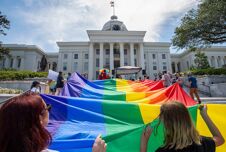The U.S. is currently in a profoundly divisive era across political and cultural lines. Nowhere is this clearer than in the ongoing and coordinated assault on equity, including the backlash against progress made in recent years on racial justice and LGBTQ+ rights.
As of 2023, 589 bills targeting the transgender community have been introduced across 49 states. This attack doesn’t exist in a vacuum but instead has been paired with the onslaught of legislative measures challenging Critical Race Theory (CRT) and restricting open discussion of race.
Related:
The right wing is lumping trans student rights in with Critical Race Theory
The goal is to recreate the toxic brew of hatred, division and fear that propelled Trump into the White House.
As a queer Black man and a queer Asian man who both also work as social change advisors, we can’t ignore the intersection of this attack. It’s from this vantage point that we come to the topic of reparations — a comprehensive federal program that addresses the legacy of slavery and the centuries of documented race-based policies thereafter — which the same anti-equity forces oppose. Over the past year, we have been part of a team responsible for new research from The Bridgespan Group and Liberation Ventures on the role that philanthropy can play in supporting the reparations movement and fostering a culture of repair.
Dive deeper every day
Join our newsletter for thought-provoking commentary that goes beyond the surface of LGBTQ+ issues
Too often the discussion around reparations focuses on it as a destination, just an overdue paycheck, rather than on the repair and healing that reparations can bring to our nation. If we stay focused on the equitable world that we are trying to build, then it becomes clear that the goals of the movements for queer liberation and for reparations for Black people are more aligned than not. The opposition has already seen the value of a coordinated anti-LGBTQ+ and anti-Black attack. It’s time to embrace the power that a united front for equity can bring.
“On the other side of reparations for the Black community, it looks like pure joy and liberation,” said Robin Rue Simmons, founder and executive director of FirstRepair, a nonprofit working nationally to educate and equip leaders, stakeholders, and allies who are advancing local reparations policies. “For the rest of the world, it looks like the mountaintop that King preached about.”
To arrive on that mountaintop, we must acknowledge that the reparations movement intersects with the liberation of the LGBTQ+ community.
The reparations movement also can learn — and draw inspiration and hope — from the campaign for marriage equality, which faced similar headwinds from the same anti-equity players. Support for reparations among all U.S. adults now stands at 30 percent, roughly the same level of support that same-sex marriage had a decade before it became the law of the land in 2015. Younger generations express even more support: Between 45 and 57 percent of Americans aged 18 to 29 support reparations. To leverage that momentum, the fight for reparations requires the same level of strategic coordination that advanced marriage equality.
But unlike the campaign for marriage equality, to succeed in healing the nation, the movement for reparations requires Black queer and transgender people to be positioned at the center of this campaign, rather than at the margins. And while more needs to be done, a glimpse at how funders and Black movement leaders are already considering the role of LGBTQ+ communities within the burgeoning movement for repair offers hope.
“People reject this notion of intersectionality inside of reparations because they fear scarcity, but we have to consider where identities merge,” said Malkia Devich-Cyril, an activist, writer, and public speaker on issues of digital rights. “When we consider Black queerness and Black trans identity, for example, there is a specific arena of redress for these groups. In what ways did enslavement, Black Codes, and Jim Crow prevent the free expression of Black gender identity, and what was the cost? We have to be able to calculate the cost.”
We agree that the redress must be tantamount to the harms, which requires a tailored — rather than one-size-fits-all— approach. To get there, we must embrace expansive ways of thinking about how we can repair and heal our nation. If healing and repair are at the forefront of philanthropic giving, Black queer and trans people must be front and center for that to happen.
Our collective efforts — including our giving — must be coordinated to take on these challenges. Every Black issue is a queer issue, and every queer issue is a Black issue.
















The reparations & LGBTQ+ rights movements are aligned. Let’s harness the power of a united front.